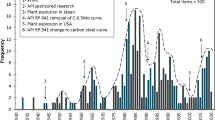Abstract
The concept of the complete Sawblade Corrosion Cycle (SCC), covering both the operational and non-operational (idling) phase in a working life of a saw has been proposed and a tentative mathematical expression for practical assessment of sawblade deterioration due to combined effects of chemical corrosion and physical wear, established. (SCC) values calculated on that basis confirm that the sawblade weight losses expressed in g/m2/h, are higher then credited and have a considerable influence on the overall performance of the saw and its working life.
Preliminary calculations within non-operational, i.e. the idling phase of (SCC), show that a correct timing of saw cleaning procedure after use can save some 2–4% of the total blade material in weight, which is otherwise lost in a normal mill practice.
These findings suggest a simple and inexpensive way of both improving the sawblade performance and extending its working life considerably.
Zusammenfassung
Das Konzept eines vollständigen Sägeblatt-Korrosions-Cyklus (SCC), welcher sowohl die Arbeits-als auch die Ruhephasen umfaßt, wurde bereits früher vorgestellt zusammen mit einem versuchsweisen Ansatz zum Abschätzen des Korrosionsgrades infolge der kombinierten Wirkung chemischer und physikalischer Faktoren. Werte, die auf dieser Grundlage errechnet wurden, bestätigen, daß der Sägeblattverlust in g/m2/h größer ist als bisher angenommen und einen beträchtlichen Anteil am gesamten Sägeblattverhalten und der Standzeit hat. Vorläufige Berechnungen der Verluste während der Stillstandzeiten zeigen, daß pünktliches Einhalten der Reinigungsverfahren ca. 2–4% des gesamten Materialverlustes verhindern können. Damit ist eine einfache Möglichkeit gegeben, das Sägeblattverhalten und die Standzeiten beträchtlich zu verbessern.
Similar content being viewed by others
Literature
Bootle, K.R. 1983: Wood in Australia: types, properties and uses. Sydney: McGraw-Hill Book Company
Krilov, A. 1985: Effects of commercial timbers on the corrosion and wear of sawblade steels: Laboratory assessments of loss in weight and thickness of four steels. Pap. 10–12 Vol. 3 Proc. For. Prod. Res. International, Pretoria
Krilov, A. 1986: Corrosion and wear of sawblade steels. Wood Sci. Technol. 20:363–370
Krilov, A.; Gref, R. 1986: Mechanism of sawblade corrosion by polyphenolic compounds. Wood Sci. Technol. 20:371–378
Krilov, A. 1987: Corrosive propeties of some Eucalypts. Wood Sci. Technol. 21:211–217
Krilov, A. 1988: Karri & Jarrah Corrosion Project (W.A.) For. Com. NSW Rep. No. 11655/1
Krilov, A.; Lasander, W.H. 1988: Acidity of heartwood and sapwood in some Eucalypt species. Holzforschung 42(4):265–271
Krilov, A.; Lasander, W.H. 1989: Concentration, distribution and variability of butanol-soluble phenolic compounds in Eucalypt heartwood. Holzforschung 43(1):49–54
Author information
Authors and Affiliations
Additional information
Invited paper for the Saw Tech '90 First International Conference on Sawing Technology, San Francisco, October 1989
Rights and permissions
About this article
Cite this article
Krilov, A. Sawblades: To clean or not to clean?. Holz als Roh-und Werkstoff 48, 355–359 (1990). https://doi.org/10.1007/BF02639898
Issue Date:
DOI: https://doi.org/10.1007/BF02639898




